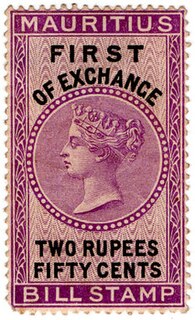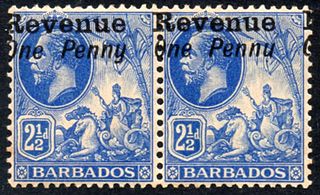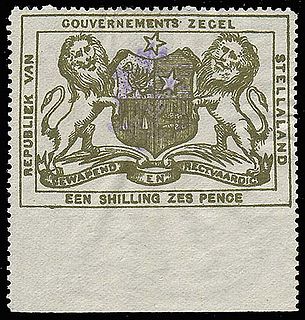Belize started as the colony of British Honduras, formally established in the 17th century but disputed through the 18th century.

Mauritius issued revenue stamps from 1 March 1869 to 1904. There were various types of fiscal stamps for different uses.

Zanzibar issued revenue stamps from when it was a British protectorate in 1892, to after when it became part of Tanzania in 1993.

The British colony of Zululand issued revenue stamps in 1888. The only set consisted of seven values of 1d, 1s, 5s, 9s, £1, £5 and £20 of Natal revenues overprinted ZULULAND in a similar overprint to that used for postage stamps. The 1d later became valid for postal use as well. All the higher values now command high prices and are quite rare. In addition to this issue, the same Natal £5 is known with a different overprint in violet, but it is not known if this was a legitimate issue or not.

The island of Cyprus first issued revenue stamps in 1878 and continues to do so to this day. The Turkish Republic of Northern Cyprus also issues its own revenue stamps.

British Guiana, now known as Guyana, first issued revenue stamps in 1865 and continues to do so to this day.

The island of Barbados first issued revenue stamps in 1916. There were various types of fiscal stamps for different taxes.

Bechuanaland first issued revenue stamps as Stellaland in 1884. Note: this information is wrong. Bechuanaland was split into British Bechuanaland and the Bechuanaland Protectorate. British Bechuanaland was added to the Cape Colony and the Bechuanaland Protectorate was governed from Mafeking until the seat of government was moved to Gaberone.

The South African Republic (ZAR), later known as Transvaal issued revenue stamps from 1875 to around 1950. There were a number of different stamps for several taxes.

Kenya, formerly known as British East Africa issued revenue stamps since 1891. There were numerous types of revenue stamps for a variety of taxes and fees. Also valid for fiscal use in Kenya were postage stamps issued by the following entities:

Nyasaland, now known as Malawi, first issued revenue stamps as British Central Africa in 1891 and continued to do so until the late 1980s.

Hong Kong issued revenue stamps from 1867 to the 1990s, both when it was a British colony as well as when it was under Japanese occupation.

Malaysia first issued revenue stamps as the Straits Settlements in 1863, and continues to do so to this day. Over the years, a number of entities in modern Malaysia have issued revenue stamps.

Over the years various Malay States issued their own revenue stamps. Now most states use Malaysian revenue stamps, except for Singapore which is independent and no longer uses revenue stamps.

Uganda issued revenue stamps from around 1896 to the 1990s. There were numerous types of revenue stamps for a variety of taxes and fees.
Revenue stamps of Fiji were first issued in 1871, when the Fiji islands were an independent kingdom. The first revenue stamps consisted of postage stamps overprinted with the letter D.
Revenue stamps of Seychelles were first issued in 1893, when the islands were a dependency of the British Crown Colony of Mauritius. The first stamps were Mauritius Internal Revenue stamps depicting Queen Victoria overprinted for use in Seychelles, and Bill stamps were also similarly overprinted. Postage stamps depicting Victoria or Edward VII were overprinted for fiscal use at various points between 1894 and 1904, while surcharges on Bill stamps were made in around 1897–98.
Few revenue stamps of Nigeria and its predecessor states have been issued, since most of the time dual-purpose postage and revenue stamps were used for fiscal purposes. The first revenue-only stamps were consular stamps of the Niger Coast Protectorate and the Southern Nigeria Protectorate, which were created by overprinting postage stamps in 1898 and 1902 respectively. The Northern Nigeria Protectorate did not issue any specific revenue stamps, but a £25 stamp of 1904 could not be used for postal purposes due to its extremely high face value.
Revenue stamps of British Somaliland refer to the adhesive revenue or fiscal stamps which were issued by British Somaliland, a British protectorate in present-day Somaliland, between 1900 and 1904. All Somaliland fiscals were revenue stamps of India overprinted BRITISH SOMALILAND.

A postage and revenue stamp, sometimes also called a dual-purpose stamp, is a stamp which is equally valid for use as a postage stamp and as a revenue stamp. They often but not always bear an inscription such as "Postage and Revenue". Dual-purpose stamps were common in the United Kingdom and the British Empire during the 19th and 20th centuries, and they are still used in some countries as of the early 21st century.














